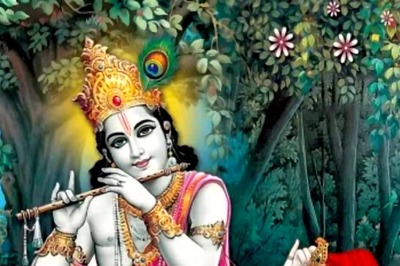
views
1. The First and Final Form
The word linga means “the form”. We are calling it “the form” because when the un-manifest began to manifest itself, or in other words when creation began to happen, the first form that it took was that of an ellipsoid. A perfect ellipsoid is what we call as a linga. Creation always started as an ellipsoid or a linga, and then became many things. And we know from our experience that if you go into deep states of meditativeness, before a point of absolute dissolution comes, once again the energy takes the form of an ellipsoid or a linga. So, the first form is linga and the final form is linga.
2. Consecrating a Linga
If you give me any object, a piece of paper for example, I can make it highly energetic and give it to you. If you hold it before and after I touch it, you will feel the difference, but the paper will not be able to sustain this energy. But, if you create a perfect linga form, it becomes a perennial storehouse of energy. Once you charge it, it will always stay that way.
Prana Pratishtha
Pratishtha means consecration. The most common form of consecration is by using mantras, rituals and other kinds of processes. If you consecrate a form through mantras, it needs constant maintenance and rituals to keep the deity alive.
Prana Pratishtha is not like that. Once a form is consecrated through life energies, not with mantras or rituals, it is forever and needs no maintenance.
3. Linga-Making – A Subjective Science
The science of linga-making is a huge experiential possibility, and has been there for thousands of years. But in the last eight or nine hundred years, especially when the Bhakti movement swept the country, the science of building a temple got washed away. For a devotee, nothing is important except his emotion. His path is emotion. It is only from the strength of his emotion that he does everything. So they just kept the science aside and started building temples whichever way they liked. It is a love affair, you know? A bhakta can do whatever he wants. Anything is fair with him because the only thing he has is the strength of his emotion. Because of this, the science of making lingas receded. Otherwise, it was a very deep science. This is a very subjective science, and it was never written down because if you write it down, it will be completely misunderstood. Many lingas have been created like this, without any knowledge of the science.
4. Lingas of the Pancha Bhutas Sthalas
The most fundamental sadhana in yoga is bhuta shuddhi. The pancha bhutas are the five elements in nature. If you look at yourself, your physical body is made up of five elements. These are earth, fire, wind, water, and space. They come together in a certain way to become the body. The spiritual process is about going beyond the physical and five elements. These elements have a huge grip on everything that you experience. To transcend them, the fundamental practice of yoga involves what is called bhuta shuddhi. For every element that is involved, there is a certain practice you can do to become free from it.
In South India, five magnificent temples were built, each with a linga representing one of the pancha bhutas. If you want to do sadhana for the element of water, you go to Thiruvanaikaval. For space, you go to Chidambaram; air, Kalahashasti; earth, Kanchipuram and fire, Thiruvannamalai.
These temples were created as places for sadhana, not for worship.
5. Jyotirlingas
Indian culture has been among the few cultures on this planet where for thousands of years, the whole population was focused only on the ultimate well-being of the human being. The moment you were born in India, your life was not about your business, your wife, your husband or your family; your life was only about mukti. The whole society was structured like this.
In this context, many kinds of powerful devices were created in this culture. Jyotirlingas were created as very powerful tools in this direction. It is a powerful experience to be in the presence of such forms.
Jyotirlingas have tremendous power because they were consecrated and created in a certain way, not just using human capabilities, but the forces of nature. There are only twelve Jyotirlingas. They are located at certain geographically and astronomically significant points. These points are subject to certain forces in the existence. A long time ago, people with a certain level of perception very carefully calibrated these spaces and fixed those points according to the celestial movement.
6. Mahakala – The Ultimate Time Machine
Shi-va literally means “that which is not” or no-thing. The hyphen is important. It is in the lap of vast no-thingness that creation happened. Over 99 per cent of the atom and the cosmos is, in fact, emptiness – simply no-thing. The one word, Kala, is used for time and space and one of the personifications of Shiva is Kala Bhairava. Kala Bhairava is a vibrant state of darkness, but when he becomes absolutely still, he turns into Mahakala, the ultimate time machine.
The Mahakala temple in Ujjain is an incredibly consecrated space, this powerful manifestation is definitely not for the faint-hearted. Raw and forceful, it is available for all those seeking ultimate dissolution – the annihilation of time as we know it.
The spiritual process anywhere in the world is always about transcending the physical, because form is subject to cycles. Kala Bhairava is seen, therefore, as the Destroyer of Ignorance: he who shatters the compulsive cycles of birth and death, being and non-being.
7. Lingas Worldwide
There was no enlightened being who did not talk about Shiva, in the sense of a boundless dimension, or something beyond physical nature. The only difference is they may have expressed it in the language and symbolism of their region.
However, because of very aggressive ways of spreading religion around the world in the last 1500 years, most of the great cultures of the past, like the ancient Mesopotamian civilisation, the Central Asian civilisations, and the North African civilisations, have disappeared. So it is not very visible anymore, but if you look deeper into history, it was everywhere. So, in some way, mystical sciences used to be present in every culture. But in the last 1500 years, they were largely lost in other parts of the world.
Ranked amongst the fifty most influential people in India, Sadhguru is a yogi, mystic, visionary and a New York Times bestselling author. He has been conferred the Padma Vibhushan by the Government of India in 2017, the highest annual civilian award, accorded for exceptional and distinguished service.
The views expressed in this article are those of the author and do not represent the stand of this publication.
Read all the Latest Opinions here


















Comments
0 comment